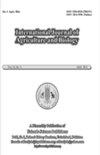Enhancement of Cellulose Rich Organic Matter Degradation by Inoculation with Streptomyces sp. Strains
Q2 Agricultural and Biological Sciences
引用次数: 0
Abstract
Microbial degradation of organic matter is a vital part of carbon cycle in nature. Actinobacteria play an important role in the decomposition of cellulose rich organic matter (CROM). Streptomyces spp. are abundant in soil, produce various secondary metabolites and secrete extracellular enzymes. The aim of this research was to isolate and select Streptomyces strains with the best cellulose degradation abilities. Out of total 32 actinobacteria isolates, four Streptomyces strains (CA1, CA10, PA2 and PA7) were subjected to morphological, physiological, biochemical characterization and molecular identification. CROM degradation potential of the strains was investigated on straw and beech briquettes as well as on legume based substrate in in vitro condition. Streptomyces strains CA1 and CA10 showed the best cellulose production and starch hydrolysis abilities, followed by strains PA2 and PA7. Strain CA1 was also positive to production of pectinase enzymes. Streptomyces zaomyceticus CA1 and S. tanashiensis CA10 were used as inoculants, which degraded the raw cellulose from 38.38 to 81.69% in the investigated substrates (straw, beech, legume), during a 30-day incubation experiment. CROM inoculation with the selected Streptomyces strains improved and accelerated its degradation in controlled conditions. © 2021 Friends Science Publishers链霉菌菌株接种促进富含纤维素的有机物降解
微生物对有机物的降解是自然界碳循环的重要组成部分。放线菌在富纤维素有机质(CROM)的分解中起着重要作用。链霉菌在土壤中含量丰富,产生多种次生代谢产物,分泌胞外酶。本研究的目的是分离和筛选具有最佳纤维素降解能力的链霉菌菌株。对32株放线菌中4株链霉菌(CA1、CA10、PA2和PA7)进行形态、生理、生化表征和分子鉴定。在体外条件下,研究了菌株对秸秆、山毛榉压块以及豆科基质的CROM降解潜力。链霉菌菌株CA1和CA10的纤维素产量和淀粉水解能力最好,其次是菌株PA2和PA7。菌株CA1对果胶酶的产生也呈阳性反应。以zaomyceticus CA1和S. tanashiensis CA10为接种剂,在30 d的培养试验中,对秸秆、山毛榉、豆科植物中纤维素的降解率从38.38%降至81.69%。在控制条件下,用所选链霉菌接种CROM可改善并加速其降解。©2021朋友科学出版社
本文章由计算机程序翻译,如有差异,请以英文原文为准。
求助全文
约1分钟内获得全文
求助全文
来源期刊

International Journal of Agriculture and Biology
AGRICULTURE, MULTIDISCIPLINARY-
CiteScore
1.70
自引率
0.00%
发文量
40
审稿时长
5 months
期刊介绍:
Information not localized
 求助内容:
求助内容: 应助结果提醒方式:
应助结果提醒方式:


